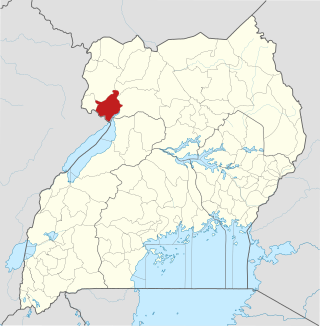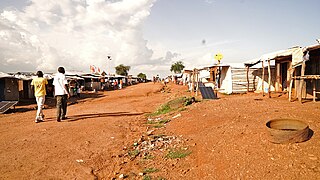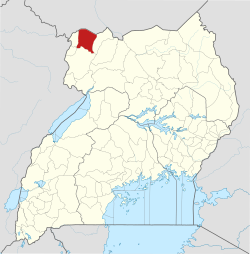
Arua District is a district in the Northern Region of Uganda. Like many Ugandan districts, it too shares its name with its administrative center of Arua. The name Arua is said to be derived from the Lugbara name for prison (Arujo) and prisoner (Aru), since the white settlers had a detention center at Arua Hill.

Moyo District is a district in Northern Region of Uganda. Like many other Ugandan districts, it is named after its "chief town", Moyo, where the district headquarters are located.

Nebbi District is a district in Northern Uganda. It is named after its main municipal, commercial and administrative centre, Nebbi, the location of the district headquarters.

Arua is a city and commercial centre within the Arua District in the Northern Region of Uganda.

Koboko District is a district in the Northern Region of Uganda. The town of Koboko is the site of the district headquarters.

West Nile sub-region, previously known as West Nile Province and West Nile District, is a sub-region in north-western Uganda, in the Northern Region of Uganda.

The Lugbara are a Central Sudanic ethnic group who live primarily in the West Nile region of Uganda, in the adjoining area of the Democratic Republic of the Congo (DRC) with a few living in South Sudan. They speak the Lugbara language, a Central Sudanic language similar to the language spoken by the Madi, with whom they also share many cultural similarities.
Yumbe is a town in the Northern Region of Uganda. It is the district headquarters of Yumbe District.
Moyo, is the main municipal, administrative, and commercial center of Moyo District in the Northern Region of Uganda. The district headquarters are located here.
Koboko is a town in Northern Region of Uganda. It is the main municipal, administrative, and commercial centre of Koboko District. Koboko is also the hometown of former dictator Idi Amin who ruled Uganda from 1971 to 1979.
The Aringa are a Central Sudanic ethnic group primarily residing in the rural areas of Yumbe District, located in the northwestern corner of Uganda. They are also found in other regions of the West Nile sub-region. The Aringa people are considered the indigenous inhabitants of their lands, which were later settled by a group known as the "Nubians." Their language, also called Aringa, belongs to the Central Sudanic language family. According to the 2014 Census of Uganda the Aringa numbered 494,626 people.
The Moru–Madi languages of the Central Sudanic language family are a cluster of closely related languages spoken in South Sudan, the Democratic Republic of Congo, and Uganda. Moru is spoken by 100,000 people, and Ma'di is spoken by twice that number. The most populous languages are Aringa of Uganda, with close to a million speakers, and Lugbara, with 1.6 million.

Maracha District is a district in the West Nile sub-region, in the Northern Region of Uganda. It was formed in 2006 from Arua District.
Agofe is the noble title for the chief cultural leader among all the Lugbara people or King of Lado Kingdom which covers the regions of West Nile, Ituri, Torit, Uele and Yei. The term means 'Pillar' or 'Paramount Chief' but a king is also called opi in Lugbara; an opi is usually the clan leader of a lineage. Around 1967, President Milton Obote abolished kingdoms, then the 1995 Constitution reinstated cultural institutions but the Lugbara only chose county chiefs. In 2012, the Government of Uganda finally recognised this revised Agofe institution. The Agofe's duty will be to preserve Lugbara culture through literature and other assignments.
West Nile Cup is the annual football tournament contested by the political districts in the West Nile sub-region of Uganda. The tournament was started in 2012 by Lawrence Mulindwa, a year before he ceased to be the president of the Federation of Uganda Football Associations, Uganda's football-governing body. The first edition was hosted by Arua and it was organised to bring West Nile together. The other mission is to identify talent for inter-region tournaments like Airtel Under 17, which can also be a backup wellspring for the Uganda Cranes, the nickname for the national team.
The Koboko–Yumbe–Moyo Road is a road in the Northern Region of Uganda, connecting the towns of Koboko, Yumbe, and Moyo.

Bidibidi Refugee Settlement is a refugee camp in the Yumbe District of northwestern Uganda. Home to over 270,000 South Sudanese refugees fleeing the ongoing civil war in mid 2016, it was among the largest refugee settlements in the world at the time, and may have been the largest. As of 2018, that distinction was claimed by Kutupalong refugee camp for displaced Rohingya in Bangladesh.
Lodonga is a town in the Northern Region of Uganda. It is one of the municipalities in Yumbe District.
Charles Collins Andaku is an Anglican bishop in Uganda: he has been the Bishop of Madi and West Nile since 2017.

Terego is a district in Uganda's Northern Region. It is located approximately 360 kilometres (220 mi) northwest of Uganda's capital Kampala. The administrative centre of the district is the trading centre of Leju in Aii-Vu Sub-County. Terego District covers an area of 1,102 square kilometres (425 sq mi) and the areas now making up the district recorded a non-refugee population of 199,303 in the 2014 Ugandan census. Terego District also hosts an estimated 168,000 refugees, mostly from South Sudan, in the Imvepi Refugee Settlement and the western zones of the Rhino Camp Refugee Settlement in the district.










